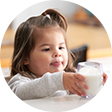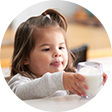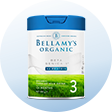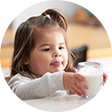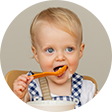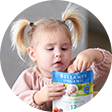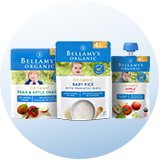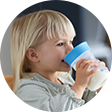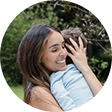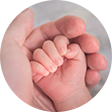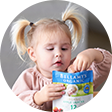Starting Solids
Starting on solid food is an important milestone in your child’s development. It’s a window of opportunity where good eating habits can be established and provides a strong foundation for your child’s future health.
When and why solid food should be introduced?
Whether your baby is being breastfed, bottle fed or a combination of both, first foods are introduced in the same way and at the same time
Experts agree this is around six months old, but not before four months
At this time, iron and zinc, key nutrients needed for growth and development, are no longer being fulfilled by breast milk or infant formula alone.
Readiness signs
Babies are all so different. Some babies will be ready for solids earlier than others, so individual signs of readiness are a better guide. Some of these signs include:
- - Interest in watching others eat and showing excitement when others are eating
- - Lost tongue-thrust reflux that pushes food back out of the mouth
- - Holds head up
- - Able to sit upright supported
- - Opening mouth when something comes towards them
- - Chewing fingers and toys
- - Reaching out for food and cutlery
Even though you may see some of these signs earlier, breastmilk or infant formula will be enough until around six months.
What you’ll need
Before you get started, there are a few items of feeding equipment you may need. These include:
- - Small soft and shallow spoon
- - Bowl
- - Bib
- - Cleaning cloths
- - Ice cube trays
- - Food blender/processor (handy, but not essential)
- - Mess mats
- - Highchair with fitted harness
- - A calm baby and lots of patience.
Timing is everything
- - Pick a time to offer solids when you and your baby are both relaxed. Morning is a good time when they are hungry and happy
- - Your baby is more likely to try solids after a feed of breast milk or formula
- - Make sure your baby is sitting upright (either in a highchair or on your lap)
- - Try to eat at the same time as your baby
- - To start with, offer 1-2 teaspoons of food or a small piece with your fingers and increase according to your baby’s appetite. Another option is to offer food from your plate, she may feel that eating food from your plate is ‘safer’ and be more willing to try it
- - Let your baby eat their way. Allow enough time for baby to explore and eat at their own pace and look for signs if they’re not interested anymore
- - If they don't seem to like some foods, leave them for a few days and then offer them again.
Types of food
Start with iron and zinc containing foods (remember, the iron stored in your baby’s body starts to deplete around 6 months). These include iron-fortified infant cereal, minced meat, poultry and fish, cooked tofu and legumes and mashed and well-cooked egg. So long as iron-rich foods are the focus, introduce a variety of suitable textured vegetables, beans and legumes, fruit, grains and cereals and full fat dairy products like cheese and yoghurt.
Slow introduction of solid food is not necessary.
Breast or infant formula feeding is recommended alongside solids until a baby is 12 months old and for breastfeeding, for as long as the mother and baby want to keep going.
Every baby is different and there is no need to rush to start before six months. If your baby is nearing seven months of age and hasn’t started solids, you might like to get some advice from your Maternal and Child Health Nurse or GP. Remember breast milk or formula remains the main source of nutrition for the first 12 months.

